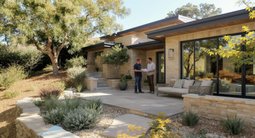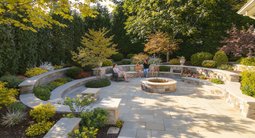TL;DR
To keep weeds and moss from growing through patio cracks, clear the joints, refill with polymeric sand, and seal to lock them tight. Improve drainage, add sun and airflow, and use heat or boiling water for spot control instead of harsh chemicals. If the base has shifted, a lift-and-reset with compacted gravel and geotextile is the long-term fix. Use this guide for how to keep weeds from growing between pavers and how to stop moss on a damp patio.
Introduction

Moisture-retaining patio joints create ideal conditions for moss and weed growth after rainfall.
After wet weather, patio joints that hold moisture for 48 hours or more become prime real estate for moss and opportunistic weed seeds. Walk any backyard after the first fall storm and you can see the pattern: shaded edges green up first, then the center hairlines fill as windblown seeds find purchase in sandy joints.
Homeowners ask for a silver bullet, but good patio maintenance is really a small set of habits. Clear the joints, lock them, shed water, and only then spot-treat what persists. I’ve watched this work in rainy Portland, in foggy coastal towns, and on humid Mid-Atlantic patios. The approach is the same: stabilize the joints, dry the surface faster, and choose gentle control where needed.
Theme Overview
Stable joints, fast drainage, and consistent light are the three levers that keep hardscape cracks cleaner, longer. Think of it like a gravel path after a storm: the sections that drain and compact stay tidy, the hollow and shaded bits sprout green.
This season’s backyard design trend tilts practical — polymeric jointing sand, joint-sealers, gentle weed control, and small design tweaks that add airflow and sun. Short-tail keywords aside, the real win is comfort: better footing, fewer slippery patches, and less time scraping cracks on your knees. You’ll see these ideas across native landscaping, backyard garden ideas, and curb appeal planting because they work with water and time, not against them.
Anecdote
Field note: A small Cape Cod courtyard I visit each spring used to green up like a sponge. We added two hours of sunlight by lifting a camellia, reshaped a puddle with a single bag of gravel, and topped the joints with polymeric sand. The owners now sweep after storms and boil a kettle once a month. That’s it.
Ideas, Tips, and Designs
01. Lock Joints with Polymeric Sand
Polymeric sand hardens in paver gaps within 24–48 rain-free hours, creating a weed- and ant-resistant joint that still drains.
What it is: A blend of fine sand and water-activated binders that firms up between pavers, brick, or stone.
How it works: After you blow or wash out loose debris, sweep polymeric sand into joints sized roughly 1/8 inch to 1/2 inch. Compact or vibrate the surface lightly, sweep clean, then mist until damp — never flood — so the binders activate without washing out. Most products set best between 50 and 90°F with 24 hours of dry weather. When cured, the joints resist seed germination and stay put through freeze-thaw cycles. Field note: in Seattle courtyards I’ve seen resanding every 3–5 years keep patios nearly weed-free.
- Use a leaf blower and a joint knife to clean cracks before sanding.
- Choose polymeric sand color that matches your pavers for a clean look.
- Keep foot traffic off for 24 hours, and no sprinklers for 48 hours.
Alt text: Close-up of polymeric sand brushed into paver joints before misting. Caption: Sweep, pack, then lightly mist — don’t flood — for a tight lock.
02. Seal the Surface to Stabilize Sand
Joint-stabilizing sealers bind sand grains and shed grime, extending weed-free intervals by a season or more.
What it is: A water-based acrylic sealer designed for pavers that locks joint sand and adds light stain resistance.
How it works: Once the polymeric sand cures, roll or spray a joint-stabilizing sealer in thin coats. Aim for a 2–3 hour recoat window and 24 hours dry. Sealers help keep fines from washing out, reduce dust, and make it harder for airborne seeds to stick. Semi-matte finishes look natural; high-gloss can highlight texture but may be slick when wet. Expect reapplication every 2–3 years depending on sun and traffic.
- Apply when temps are above 50°F and no rain is forecast for 24 hours.
- Test a small area first to confirm sheen and color enhancement.
- Blow off leaves often; debris traps moisture that favors moss.
03. Regrade for Drainage and Faster Drying
A 2% slope, or roughly 1/4 inch per foot, helps patios shed water so joints dry in hours, not days.
What it is: Minor surface corrections so water runs away from the house and off the patio quickly.
How it works: Standing water and long dry times invite moss. If puddles linger after rain, lift the low area, add compacted 3/4-inch minus gravel in 2-inch lifts, and relay the pavers on 1 inch of screeded concrete sand. Add a discreet drain or a narrow gravel strip to catch runoff if needed. In my visits to wet-summer yards, this single fix reduced moss by half without chemicals.
- Mark puddle spots after a storm, then correct them when weather clears.
- Add a 6–12 inch perimeter gravel band near planting beds to intercept soil and seeds.
- Keep gutters and downspouts from dumping onto the patio surface.
04. Add Sunlight and Airflow to Discourage Moss
Moss struggles with 4–6 hours of direct sun and good airflow, so pruning can be a quiet, permanent solution.
What it is: Light canopy thinning and limb lifting to dry the patio faster.
How it works: Moss thrives where pH is mildly acidic and light is low. By lifting branches to 8 feet or more on adjacent shrubs and selectively thinning dense canopies, you increase sun flecks and airflow that evaporate overnight moisture. Pair this with a stiff-bristle broom routine after rains. Horticulturists note even 1–2 extra sun hours can shift the balance from green to clean.
- Target limbs casting shade on the dampest patio zones.
- Use a broom or brush weekly; abrasion interrupts moss rhizoids.
- Top-dress nearby beds with mulch to reduce soil splash onto pavers.
05. Heat and Steam for Chemical‑Free Spot Control
Boiling water, steam weeders, or a careful flame pass can desiccate small weeds in seconds without residue.
What it is: Thermal weeding tools that rupture plant cells and wilt foliage on contact.
How it works: For annuals and seedlings, a 5–10 second exposure to 200°F+ steam or near-boiling water collapses leaves and stems; roots of mature perennials may need repeat passes. Propane torches work when the surface is bone-dry and local rules allow, but avoid near mulch or polymeric sand and keep a hose handy. I’ve seen gardeners in Arizona run a quick weekly pass during monsoon season to stay ahead of flushes.
- Pour boiling water along edges where grass creeps in.
- Choose a shrouded torch or electric steamer for precision near wood.
- Return in 7–10 days to treat any resprouts.
06. Gentle Cleaners That Don’t Salt the Earth
Oxygenated cleaners (sodium percarbonate) lift organic film without the long-term soil damage caused by salt or strong acids.
What it is: A non-chlorine, oxygen-release powder that foams away algae and light moss on contact.
How it works: Mix per label, wet the surface, apply, and agitate with a stiff brush after 10–15 minutes. Rinse toward a gravel strip or lawn. Avoid repeated vinegar or salt applications; both can harm nearby plants, corrode metal, and raise salinity that lingers in joints. A quarterly oxygen clean paired with weekly sweeping is often enough in shaded courtyards.
- Spot-test on a hidden paver before broad use.
- Rinse thoroughly, especially near ponds or delicate plants.
- Wear gloves and eye protection; bristles can flick solution.
07. Embrace a Managed Moss Look
A deliberate moss ribbon can be beautiful if you keep primary walkways clear and rough-textured.
What it is: A design choice, not a failure — encourage moss in low-traffic borders while maintaining 18–24 inch clear paths.
How it works: Moss packs nicely between old brick or flagstone, especially in zones with under 3 hours of direct sun. Define the look with clean edges, use rougher pavers for grip, and brush paths after each rain. I’ve watched homeowners in the Pacific Northwest lean into this, treating moss like a living grout, then keeping the dining zone crisp with polymeric sand.
- Keep the main patio doors-to-table route weed-free and well-textured.
- Use a border planting to frame mossy sections and signal intent.
- Add traction sand or mats where slip risk is highest.
Alt text: Moss ribbon between antique bricks beside a clear main walkway. Caption: Let the edges go soft, keep the path clean and grippy.
08. Lift-and-Reset for a True Restart
If weeds persist and pavers rock underfoot, a reset with compacted base and geotextile is the durable fix.
What it is: A rebuild of the foundation to stop movement that opens new gaps for seeds.
How it works: Pull pavers, excavate 6–8 inches, lay a woven geotextile to separate soil from base, and add 4–6 inches of compacted 3/4-inch minus gravel in 2-inch lifts. Top with 1 inch of screeded concrete sand, relay pavers with 1/8–3/16-inch joints, vibrate with a plate compactor, then finish with polymeric sand and sealer. In freeze-thaw regions (USDA Zones 4–6), that structure is what keeps joints tight year to year.
- Rent a plate compactor; two slow passes per lift are standard.
- Confirm the 2% slope away from structures as you relay.
- Photograph the laying pattern before demo for easy reassembly.
Alt text: Cross-section sketch of patio base layers showing soil, geotextile, gravel, sand, and paver. Caption: Stable layers mean tighter joints and fewer weeds.
Transitional Reflection
The beauty of modern hardscaping is not sterility, it’s stewardship. When you tune drainage, light, and joints, maintenance drops to a brisk sweep and the occasional kettle of boiling water.
Nature will always test the edges, and that’s fine. A few green threads tell you the patio is breathing, not failing.
How to Visualize It
Before you lift a single paver, map your space virtually so every fix targets the right spot. Platforms like ReimagineHome let you preview patio layouts, joint patterns, sunlight paths, and planting edges — turning sketches into living blueprints you can trust.
Visualization Scenario
Not sure where to add slope or how a moss ribbon would look along the edge? Upload a photo and test options in ReimagineHome — try a soldier course border, different paver colors, and sun-angle overlays to predict which zones dry fastest.
FAQ
What is the best way to keep weeds from growing between pavers?
Use polymeric sand to refill clean joints, then apply a joint-stabilizing sealer; this combination blocks seeds and keeps sand from washing out.
Does vinegar or salt kill patio weeds?
They can burn foliage, but repeated use can harm nearby plants, corrode metal, and raise soil salinity; gentler oxygenated cleaners and heat are safer.
Will a weed torch work on a wet patio?
Torches can desiccate small weeds but should only be used on dry surfaces, away from mulch or polymeric sand, and where local fire rules allow.
How often should polymeric sand be replaced?
Most patios need touch-ups every 3–5 years; heavy traffic, freeze-thaw, or pressure washing may shorten that interval.
Is landscape fabric under pavers worth it?
A woven geotextile under the gravel base is helpful during a rebuild, but fabric won’t stop weeds that germinate in the top joints.
How do you remove moss on a shaded patio without chemicals?
Brush after rains, improve light and airflow, and use boiling water or an oxygenated cleaner; repeat monthly during the wet season.
Closing Reflection
Good patios get better with time, not harder to live with. Lock the joints, shed the water, invite a little sun, and keep a gentle hand on control. I’ve seen patios once smothered in green become easy company: breakfast under dry flagstones, a broom leaning by the door, and no harsh sprays in sight. That’s the balance — a backyard design that respects the outside as living, while giving your feet a clean, steady place to land.
.svg)

.svg)










.png)